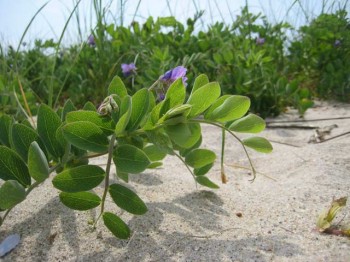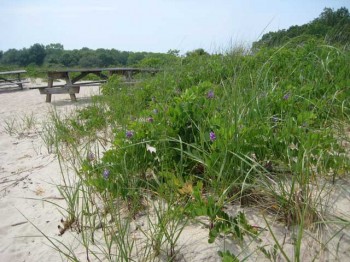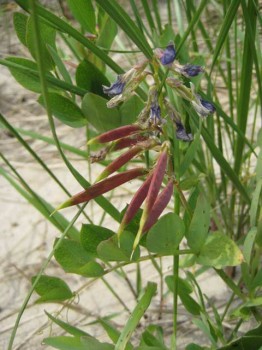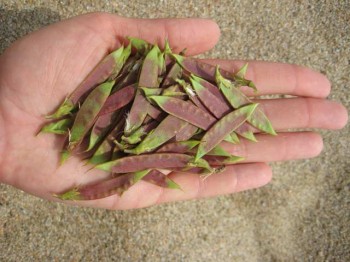
I ran into an old high school friend at the beach in Connecticut the other day. She was busy chasing around her two toddlers who kept trying to pick the pretty purple flowers in bloom amidst the dunes. “Don’t pick those flowers,” she admonished. “Don’t go in the grass. We need to keep the dunes healthy.” She was right, of course—because sand dunes and the plants therein often play an important role in protecting the land against storm surges—but at the time I was glad she hadn’t seen me picking pea pods from those same dunes just a few hours earlier!
The purple-flowering plant that captured the children’s attention was also the one that had captured mine—Lathyrus japonicus, the wild beach pea. Lee Allen Peterson (1977) puts the range of this plant as the east coast of the United States south to New Jersey, in addition to the shores of the Great Lakes, Oneida Lake, and Lake Champlain. Plants for a Future, the U.K. based “resource and information centre for edible and otherwise useful plants,” expands the range to include sandy coasts from Alaska to northern California, western and eastern Europe, and eastern Asia/China.

Pea Parts You Can Put Away
Different sources give different instructions as to which parts of Lathyrus japonicus are good for eating. Peterson (1977) says to eat the seeds, or peas, which makes sense to me. Wildflower.org (which incidentally includes Chile and Japan in the plant’s range and offers a state-by-state list of where it is found in the U.S.) says that the young peapods are also edible.
In an article for Martha’s Vineyard Magazine, Holly Bellebuono and Catherine Walthers suggest snipping and lightly steaming the wild pea tendrils, although I can’t imagine you’d be able to collect enough for more than a garnish.
Jim Meuninck’s site, herbvideos.com, states of Lathyrus japonicus var. maritimus that “the new growth (stalks of spring) may be stir fried, boiled, steamed and eaten.” He also adds that “dried peas may be cooked like coffee, roasted, then percolated (Alaskan Eskimos)” and that “Iroquois ate as cooked greens, new shoots of spring.” I have yet to try the new shoots of wild peas, but will report on it here just as soon as I get a chance to do so.

Eat Beach Peas in Reasonable Quantities
Interestingly enough, the Connecticut Botanical Society asserts that “the beach pea is NOT edible.” (The all-caps emphasis is theirs.) I assume this inconsistency might be accounted for by the fact that the seed of Lathyrus japonicus “contains a toxic amino-acid which, in large quantities, can cause a very serious disease of the nervous system known as ‘lathyrism,’” according to Plants for a Future, which goes on to explain that “the seed is said to be perfectly safe and very nutritious in small quantities, but should not comprise more than 30% of the diet.” So, in other words, if you’re foraging on the beach for an accent or side dish, you should be fine. If you’re stranded on a desert island and run out of food, try to keep the beach pea consumption down below 30%.
If It’s Wild, I’ll Eat It
I tried a small sample of Lathyrus japonicus last summer for the first time, boiling my late-August-foraged pods for 15 minutes and attempting to eat one in its tough and stringy entirety before shelling and eating just the peas. They tasted like peas, as you might imagine, and I did not get sick. A few days ago I harvested a second batch, this time the young pea pods.

Today I fried them up like snow peas in a stir fry with tofu cubes, red bell peppers, and finely chopped dandelion flowers with soy sauce and pineapple teriyaki (for lack of ginger), served with brown rice. The foraged pea pods lacked the crunch and sweetness of snow peas, but they definitely added visual appeal and a good wild texture to an ordinary dish. I’ll do it again next summer, for sure!
A Word of Caution About Rocky Mountain Legumes
Since I write primarily about edible plants in the Colorado high country, I feel it is my duty to pass on a word of caution from Cattail Bob Seebeck about Rocky Mountain legumes, lest the reader confuse the Rockies with the Connecticut shoreline. According to Seebeck (Best-Tasting Wild Plants of Colorado and the Rockies, 1998), “most wild bean pods in [the Rocky Mountains] are moderately poisonous.” He explains that although many people seem to think the wild sweet pea (Thermopsis spp.) is edible, consumption of a handful or more “will produce nausea, dizziness and headache.” So, I just wanted to note this here lest my tendency to write about wild edibles in different regions confuse the reader.
Home Sweet Colorado Home
As of yesterday, I’m home in Colorado once more. The beach peas are the only wild edible plant that made the journey home from the east coast with me this time, in part because my cooler pack exploded in my cooler bag the day before my trip, rendering it gooey and of questionable safety for contact with food.
No matter; I am enthralled by this spring’s growth, even here at 11,000 feet! Today I gleefully roamed the (slightly lower elevation) forest gathering cow parsnip, dock shoots, and dandelion flowers—so stay tuned; I’ll be writing about those just as soon as I can consume them. In the meantime, happy foraging!

I came across these yesterday while on a rocky beach on the the Oregon coast. I ate a couple peas out of the tender green pods, while my sister cautioned they may be poisonous, next time I will collect some…keeping in mind the 30% 😉
I’m doing a project for my AP environmental science class and i was given the beach pea to do a report on. One of the requirements is that you need a culinary and medicinal recipe and to make one of them. I’ve had no problem finding the culinary recipes, but i can’t find a medicinal recipe and i’ve search for hours. Do you know any medicinal recipes if you do please e-mail me at . Thank you.